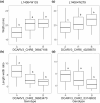Linkage mapping of root shape traits in two carrot populations
- PMID: 38412554
- PMCID: PMC10989876
- DOI: 10.1093/g3journal/jkae041
Linkage mapping of root shape traits in two carrot populations
Erratum in
-
Correction to: Linkage mapping of root shape traits in two carrot populations.G3 (Bethesda). 2024 Nov 6;14(11):jkae227. doi: 10.1093/g3journal/jkae227. G3 (Bethesda). 2024. PMID: 39331517 Free PMC article. No abstract available.
Abstract
This study investigated the genetic basis of carrot root shape traits using composite interval mapping in two biparental populations (n = 119 and n = 128). The roots of carrot F2:3 progenies were grown over 2 years and analyzed using a digital imaging pipeline to extract root phenotypes that compose market class. Broad-sense heritability on an entry-mean basis ranged from 0.46 to 0.80 for root traits. Reproducible quantitative trait loci (QTL) were identified on chromosomes 2 and 6 on both populations. Colocalization of QTLs for phenotypically correlated root traits was also observed and coincided with previously identified QTLs in published association and linkage mapping studies. Individual QTLs explained between 14 and 27% of total phenotypic variance across traits, while four QTLs for length-to-width ratio collectively accounted for up to 73% of variation. Predicted genes associated with the OFP-TRM (OVATE Family Proteins-TONNEAU1 Recruiting Motif) and IQD (IQ67 domain) pathway were identified within QTL support intervals. This observation raises the possibility of extending the current regulon model of fruit shape to include carrot storage roots. Nevertheless, the precise molecular mechanisms through which this pathway operates in roots characterized by secondary growth originating from cambium layers remain unknown.
Keywords: Daucus carota var sativus; OFP-TRM and IQD plant regulon; genetic mapping.
© The Author(s) 2024. Published by Oxford University Press on behalf of The Genetics Society of America.
Conflict of interest statement
Conflicts of interest. The author(s) declare no conflict of interest.
Figures





References
-
- Andersen SB, Christiansen I, Farestveit B. 1990. Carrot (Daucus carota L.): in vitro production of haploids and field trials. In: Bajaj YPS, editors. Haploids in Crop Improvement I. Berlin: Springer. p. 393–402.
-
- Banga O. 1957. Origin of the European cultivated carrot. Instituut voor de Veredeling van Tuinbouwgewassen. 6(1):54–63. doi:10.1007/BF00179518. - DOI
-
- Banga O. 1963a. Main Types of the Western Carotene Carrot and Their Origin. Main Types of the Western Carotene Carrot and Their Origin. Ithacca, NY: W.E.J. Tjeenk Willink.
Publication types
MeSH terms
Grants and funding
LinkOut - more resources
Full Text Sources
Miscellaneous
